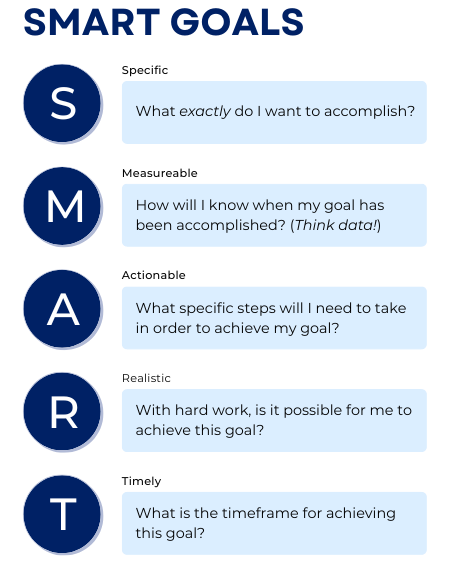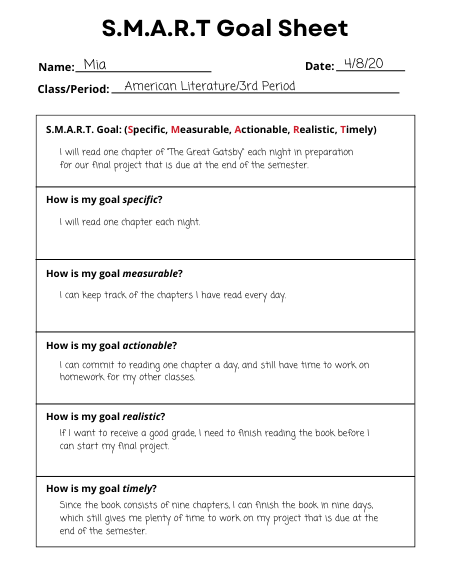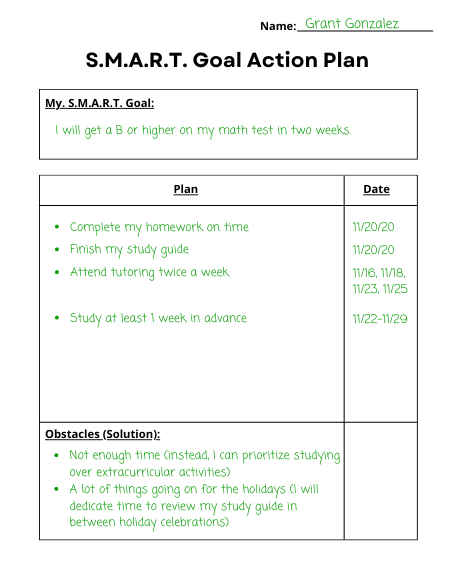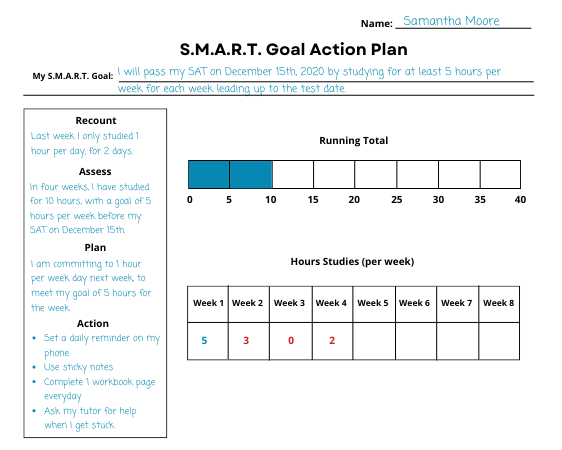Setting Goals to Improve the Executive Function Skills of Planning and Prioritizing
Planning and prioritizing are essential life skills because they help a person identify and focus on not only what needs to be accomplished, but the order in which the tasks should be done. It is indeed a very rare occurrence when a person only has one or two things on his/her to-do list! Being able to construct a plan and then prioritize the necessary events and steps is an essential 21st century skill, in that it is necessary for balancing and maintaining a relatively sane life.
Although related, planning and prioritizing are not the same, but they are two sides of the same coin. In fact, the two are so interconnected that plans would immediately turn to ruin if they were not able to be effectively prioritized. For educational purposes, planning and prioritizing are defined as follows (Remoreras, 2011).
- Planning is thinking about the tasks required to achieve a desired goal. As students mature, they are gradually expected to exercise greater control over their ability to plan. However, to do so, the art of planning must be modeled and practiced over the course of time so that students can be successful on their own.
- Prioritization ensures that you are doing the right tasks, and in the correct order. Dawson and Guare (2009) define prioritization as, “The ability to create a roadmap to reach a goal or to complete a task. It also involves being able to make decisions about what’s important to focus on and what’s not important” (pg. 8).
Let’s face it: time is a precious limited resource. Being able to prioritize allows students to make the best use of their limited time and resources when demands are high and often seem to be without limit. As students progress through the grades, they are bombarded with “ASAP” demands on a never-ending basis — do the first twenty math problems, practice the new vocabulary words, read three chapters in the class novel, and work on the PBL (project-based learning) project so that it is ready by the due date. Add other outside responsibilities such as soccer practice, household chores, and making time to spend with friends and family and it’s no wonder students can become overwhelmed.
Proximal Goals: The Path to Better Executive Skills
Research has shown that proximal goals, or ones that are attainable in a fairly short amount of time, provide more immediate incentives for students who have executive skill deficits. For example, a proximal goal such as, “I will read one chapter of The Great Gatsby tonight” has been found to be much more effective in stimulating students’ planning and prioritization skills than a more long-term distal goal such as, “I need to finish reading The Great Gatsby by the end of the month.” (Schunk, 1980; Meltzer, 2010). The reason for this is that because in addition to being more detailed and specific, proximal goals are also more personal and attainable, given the shorter timeframe. Because of this, proximal goals lend themselves more easily to intrinsic motivation and self-efficacy (Bandura & Schunk, 1981).
There are many benefits of setting specific proximal goals for students. First, goal setting increases student motivation. When students have a specific, short-term goal to attend to, motivation is increased, as they now have a specific focus for which they are working. Second, setting goals increases achievement. Since goals should be directly tied to data, targeting a specific deficit boosts knowledge and achievement. Finally, students start to feel a sense of accomplishment as goals are conquered, one by one. Oftentimes, students tend to view a daily difficult task as impossible, or insurmountable. For example, when thinking about running a marathon, how overwhelming does twenty-six miles seem? However, if you start by running just one mile, then two, then three, etc., before you know it, the twenty-six miles seem to fly by! By establishing small, manageable goals, students can chip away at that once-impossible task which stimulates their executive skills so that they can feel a sense of accomplishment and pride.
Writing Goals that are S.M.A.R.T.
Writing effective goals is a process and therefore, it will take some time for students to master both writing and achieving their goals. The following are some suggestions of things to consider before starting goal writing with your students.
- Look at the data. When working with individual students, it is important to practice data-driven instruction (both formal and informal). Data patterns need to be analyzed. For example, if you are teaching how to divide fractions by fractions (6.NS.A.1) but a student does not even know all his/her basic division facts, s/he should be made aware of his/her goal. Then, the teacher and the student can work together to set smaller, proximal goals so that the ultimate mastery of the standard can be achieved. Teachers should be sure to seek out areas in which individual students feel they struggle. This part of the process is critical, as students need this data to create meaningful proximal goals for themselves.
- Guide students in setting goals. It can be difficult for teachers to let students take the lead when setting goals, as most teachers have their own goals in mind for their students. However, it is crucial for students to determine their personal goals on their own, even though it is perfectly acceptable to prompt and/or guide them along the way. Encourage students to select only one or two goals at a time so that the task itself does not become an overwhelming process. Finally, make sure that students are thinking S.M.A.R.T. when choosing their goals. The S.M.A.R.T. acronym, as shown below, is a great guide for helping students write Specific, Measurable, Actionable, Realistic, and Timely goals. Look at the difference in the following two goals. Which one is a SMART goal?
| Goal #1 | On my next math test, I will get an "A" because I turned in all my homework. |
| Goal #2 | On my next math test on Wednesday of next week, I will increase my overall score from my last test. I will accomplish this by taking better notes and reviewing them every night to better prepare for the test. I will also complete homework before any other nighttime activities and will advocate for myself in class when I am confused by something. |
The second goal is a S.M.A.R.T. goal, as it is specific (increasing the overall math grade from a prior test), measurable (e.g., a math test score), actionable (e.g., taking better notes, reviewing notes, and completing homework), realistic (it is more than possible to increase one’s grade from one test to the next, provided the student puts forth the required effort), and has a timeframe (e.g., on Wednesday of the next week). The first goal is too vague and does not incorporate all the S.M.A.R.T. elements. When writing S.M.A.R.T. goals, it will take time and trial and error, but eventually students are bound to grasp the concept and the resulting benefits.
To keep students focused on their S.M.A.R.T. goals, it might prove beneficial to keep an anchor chart, such as the one below, front and center. It should be placed in a prominent location and teachers should refer to it often throughout the course of the school year.

Once you feel students have a solid grasp on all that goes into making a S.M.A.R.T. goal, it is time to let them loose so that they can try to set their own. Students can simply write down their goals on a piece of paper to be kept in their journals, or you can provide them with a pre-made blank form, such as the one shown below. View more examples of goal-setting forms here.

During whole-class conversations, be sure to practice reviewing what makes a goal S.M.A.R.T. Allow students to share their goals and then have the class determine if they are, in fact, S.M.A.R.T. This helps set the expectation that everyone has a goal, and it is everyone’s responsibility to help each other complete the necessary steps to achieve it. Especially in the very beginning of this process, some students may struggle with developing their own S.M.A.R.T. goals. In these instances, the teacher could instead provide a predetermined list of goals and have students work in groups to determine which goals are S.M.A.R.T.
Keeping Goals on track
What if students are struggling to meet their goals? It can be easy for students to give up and abandon their goals when they feel like they’re struggling to achieve them. For students who have executive skill deficits or are simply having a harder time meeting their goals, assist them in reevaluating their goals by examining the progress they’ve made and identifying any roadblocks that may have come up (or will come up in the future) by teaching them a strategy known as the PDCA Cycle. This is also referred to as the Deming Wheel or Deming Cycle because it was made famous by the statistician, Dr. William Edwards Deming.
| Plan |
What specifically are you trying to accomplish? What can you do differently from last week? Ask yourself the following questions to help you determine steps that need to be taken. What is my S.M.A.R.T. goal? What changes can I make to my previous plan? How will I know that a change is actually an improvement? |
| Do |
Carry out your plan. Keep track of any obstacles and list possible solutions. What strategies will you use this week to help you reach your goal? |
| Check |
Review your progress and summarize what you’ve learned. Were there any areas of improvement? Is there anything that could have been done differently? |
| Adjust |
Determine any changes that need to be made. Then, determine what your next steps will be. |
To help students stay consistent in meeting their S.M.A.R.T. goals, they can develop an action plan to track their progress. The examples below illustrate how a S.M.A.R.T. Goal Action Plan can be utilized in both the lower and upper grades.
For younger students:

For older students:

Having these steps laid out ultimately helps students as they try to visualize just how they will achieve their goals. Younger students can prepare for any obstacles that might be encountered by planning the solution ahead of time. Older students can keep a running total of how many hours they spent working toward their goal per week and per month, which helps them visualize their progress as well as assess what still needs to be done. No matter what method students choose, tracking their progress makes it easier to flag any areas that may require improvement. As another layer of differentiation, have students color-code their plan each week. Younger students can put a yellow star next to the actions they achieved or a red “X” next to the ones they missed. Older students can easily see which weeks they were on track by color-coding the number of hours they worked toward their goal (hours shown in blue above), and which weeks they fell behind (hours shown in red above). When students fail to complete the steps in their action plan, they can adjust them accordingly so that their goal can still be achieved.
A Key Essential Executive Function Skill
When juggling all the responsibilities that school brings, learning to set goals, plan, and prioritize can help students manage their workload without becoming overburdened and overwhelmed. These essential executive function skills are invaluable to master and as with many executive functions, it can be difficult for some students to do so. By using the strategies outlined in this section, students can eventually learn how to juggle these various skills so that they can organize their workload to create a realistic plan of action that can be managed efficiently and effectively. Of course, this section only scratched the surface. For additional strategy ideas regarding this essential executive function, check out this article from Pathway 2 Success.
Are you curious? Want to learn more?
To learn more about the impact of executive function skills and how to use focused interventions to support students in developing their executive function skills, visit the Professional Development Institute (PDI) website or go directly to our Focused Interventions to Improve Executive Function Skills course. The Professional Development Institute has been offering quality online professional development courses to K-12 educators for over 27 years and provided training to over 345,000 teachers across the globe. We specialize in offering quality, affordable university-approved online courses that focus on the most relevant topics in education while providing practical strategies that can be implemented in the classroom immediately. All PDI courses are at the graduate-level, instructor-led, and are conducted entirely online. University credit is available through University of California Division of Extended Studies. PDI offers an extensive catalog of online courses for teachers on topics that are the most critical in today’s classrooms.
References:
Bandura, A. & Schunk, D. H. (1981). “Cultivating competence, self-efficacy, and intrinsic interest through proximal self-motivation.” In Journal of Personality and Social Psychology, 41(3), pp. 586-98.
Dawson, P. & Guare, R. (2009). Smart but Scattered: The Revolutionary “Executive Skills” Approach to Helping Kids Reach Their Potential. New York, NY: Guilford Press.
Meltzer, L. (2010). Promoting Executive Function in the Classroom. New York, NY: Guilford Press.
Remoreras, G. (2011). “What Prioritization and Planning Can Do for You.” [Blog Post]. Retrieved 09 Aug. 2021 from https://glennremoreras.com/2011/01/12/prioritization/
Schunk, D. H. (1980, September). Proximal-goal facilitation of children’s achievement and interest. Paper presented at the 88th Annual Convention of the American Psychological Association, Montréal.
Categories: executive function skills, teaching strategies

View PDI's Catalog of Courses
Check out a list of all PDI graduate-level online courses or sort by grade level or subject area.

Register Now!
Quick access to register for PDI's online courses using our secure system.

Learn More about PDI
Find out how to reach PDI and get answers to any questions you may have.
